 |
 |
 |
| |
Trends in HIV Testing, Diagnosis, and Linkage to Care among Transgender Women Tested in Tested in CDC-Funded Sites, 2012-2017
|
| |
| |
61 CDC-funded state and local health departments reported test-level data to CDC
-50 states, DC, PR, USVI, and Atlanta, Baltimore, Chicago, Houston, Los Angeles, Philadelphia, NYC, San Francisco.
full slide presentation below following this section just below
-----------------------------------------
US trends in HIV testing, linkage to care, and transmission - Mark Mascolini (03/22/19)
HIV testing up in US transgender women but new HIV rate flat
HIV testing rates among US transgender women rose more than 10% yearly from 2012 through 2017, according to results of a large CDC analysis [4]. But the HIV diagnosis rate waned only slightly over the study period.
Growing numbers of people identify as transgender women in the United States. CDC data indicate that transgender women have the highest HIV rate in the country compared with other gender groups. Much work shows that transgender women do not access HIV care as often as other groups. Because these findings come from small or geographically limited samples, the CDC undertook this analysis of a broader transgender woman population.
The CDC team defined transgender women as those assigned male sex at birth who currently self-identify as female or male-to-female transgender. The researchers analyzed data from this population collected over 2012-2017 from 61 CDC-funded local and state health departments and about 150 community-based organizations. After charting changes in HIV testing, diagnosis, and referral patterns, they used linear regression to calculate estimated annual percent change (EAPC) in these outcomes.
The 2012-2017 sample included 58,310 HIV tests in transgender women. Numbers of tests rose more than 10% yearly (EAPC 10.6%, 95% CI 9.9% to 11.3%, P < 0.001), from 8962 in 2012 to 12,758 in 2017. That gain could partly reflect a growing number of people identifying as transgender women. The new HIV diagnosis rate dropped significantly over the study period (EAPC -7.0%, 95% CI -10.6% to -3.3%, P < 0.001), but the overall decline was small, from 2.3% in 2012 to 2.1% in 2017. Table 3 compares major findings in transgender women with those in MSM and people who inject drugs.
Among newly diagnosed transgender women, linkage to medical care within 90 days almost doubled from 35.6% in 2012 to 65.4% in 2017 (EAPC 5.0%, 95% CI 1.8% to 8.3%, P < 0.001). Interviews for partner services more than doubled over those years, from 21.0% to 53.5% (EAPC 5.3%, 95% CI 1.6% to 9.1%, P < 0.001). But the rate of referral to HIV prevention services changed little, from 61.0% to 63.9% (EAPC 1.1%, 95% CI -1.7% to 4.0%, P = 0.455).
The CDC investigators cautioned that improving rates of linkage to care and interviews for partner services may partly reflect more complete data collection over the years. But they stressed that these rates remain below national objectives. They proposed that "expanding gender-sensitive HIV prevention and care may help remove social and structural barriers to services, promote sexual health, and reduce the disproportionate burden of HIV among transgender women."
HIV risk in MSM, transgender people, high-school students, new mothers - (03/25/19)
More STIs, male or transgender sex predict HIV within 2 years of STI
Three variables independently predicted HIV acquisition within 2 years of a sexually transmitted infection (STI) in a large Washington, DC study: number of STI infections or repeat infections, male gender, and transgender status [3]. Most new HIV infections occurred within 1 year of the most recent STI.
Ever-tested for HIV rate climbing but still below 50% in US
Despite 2006 CDC advice that all 13- to 64-year-olds should get tested for HIV at least once [7], the US ever-tested rate still stands well below 50%, according to a 2011-2017 CDC analysis [2] (Table 2). But proportions of people ever tested and tested in the past 12 months climbed significantly over the study period.
The CDC issued revised recommendations for HIV testing in 2006, calling for testing at least once in everyone 13 to 64 years old, and for yearly testing for high-risk groups such as MSM, people who inject drugs, and their sex partners [7]. This analysis explored data from the nationally representative Behavioral Risk Factor Surveillance System, focusing on 18- to 64-year-olds in the period 2011-2017 who self-reported ever getting tested for HIV or getting tested in the past 12 months.
The overall ever-tested rate leapt significantly from 42.9% in 2011 to 45.9% in 2017 (P < 0.001). In 2017 three groups were more likely to be ever tested than counterpart comparison groups: blacks (68.6%), 35- to 44-year-olds (58.4%), and females (48.8%). Utah had the lowest ever-tested rate in 2017, with about one quarter getting an HIV test (26.5%), while three quarters got tested in Washington, DC, the highest rate (75.5%).
CDC-funded HIV test rate falling, but linkage and referral numbers up
HIV testing funded by the Centers for Disease Control and Prevention (CDC) waned almost 2% yearly in a 2012-2017 analysis [1]. But the study charted gains in linkage to care, interviews for partner services, and referral to HIV prevention services.
In 2012 the CDC launched a focused HIV prevention program that included HIV testing and promoted routine HIV screening of all adolescents and adults and targeted testing of priority populations. The analysis presented at the HIV Prevention Conference considered CDC-funded testing data from 61 local and state health departments and about 150 directly funded community-based organizations. CDC investigators used linear regression to determine estimated annual percentage change (EAPC) for outcomes of interest.
Numbers of CDC-funded HIV tests dipped from 3.4 million in 2012 to 3.1 million in 2017 to yield an EAPC of -1.8% (95% confidence interval [CI] -1.9% to -1.8%) (Table 1). The testing rate increased for certain groups, including 30-to-39-year-olds, people 50 or older, and transgender people. The rate of new positive HIV tests declined from 0.52% in 2012 to 0.48% in 2017 for an EAPC of -0.8% (95% CI -1.1% to -0.4%). But people 20 to 29 years old had more new positive tests over that period.
The proportion of newly diagnosed people linked to care within 90 days climbed steeply from 36.0% in 2012 to 66.2% in 2017 for an EAPC of 11.1% (95% CI 10.6% to 11.7%). Over the same years interviews for partner services rose almost 6% yearly (EAPC 5.9%, 95% CI 5.3% to 6.4%), while referral for HIV prevention services jumped 3% yearly (EAPC 3.1%, 95% CI 2.6% to 3.6%).
People who previously tested positive saw 2012-2017 gains in linkage to care (EAPC 13.7%, 95% CI 13.2% to 14.2%), interviews for partner services (EAPC 4.1%, 95% CI 3.5% to 4.7%), and referral to HIV prevention services (EAPC 9.4%, 95% CI 8.9% to 9.8%).
The CDC team speculated that declines in CDC-funded HIV testing over the study period may reflect efforts to transfer payment for testing to other payers to allow more CDC funding of linkage and navigation services. Improvements in linkage and referral outcomes, they suggested, may be partly explained by improving data completeness over the study period.
PrEP prescribers multiply as adherence and persistence get high marks - (03/22/19)
from study authors: PrEP for HIV prevention is a key strategy in "Ending the HIV Epidemic". For PrEP to be effective, it must be taken as directed by a physician and during periods of time when a person is at-risk of acquiring HIV. It's important to point out that we were unable to correlate our persistence estimates with persons' risk behaviors. Hence, it is possible that some of those who stopped using PrEP may no longer need PrEP. Other studies also showed that it is common for young users to start, stop, and re-start PrEP. Our study only examined the first continuous episode of PrEP use and may miss persons who used PrEP on demand. We are planning a study to investigate HIV infection among those who had lower PrEP adherence or discontinued PrEP to better understand the impact of low persistence.
-------------------------
Trends in HIV Testing, Diagnosis, and Linkage to Care among Transgender Women Tested in Tested in CDC-Funded Sites, 2012-2017
61 CDC-funded state and local health departments reported test-level data to CDC
-50 states, DC, PR, USVI, and Atlanta, Baltimore, Chicago, Houston, Los Angeles, Philadelphia, NYC, San Francisco.
Mesfin S. Mulatu, PhD, MPH
Guoshen Wang, MS, Wei Song, MBBS, PhD, MPH, JoAnne Keatley, MSW,
Hui Zhang, MBBS, MPH, and Choi Wan, PhD
Reported by Jules Levin
National HIV Prevention Conference March 19, 2019
Atlanta, Georgia
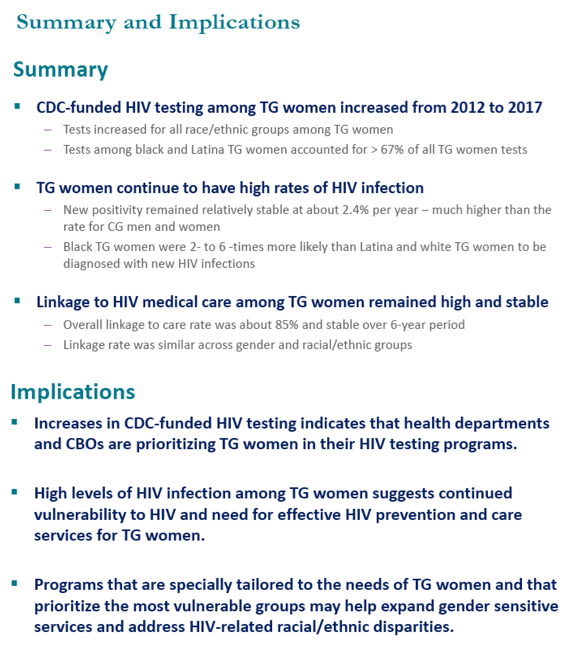
Please note that the information in the slides may differ somewhat from the abstract due to additional analyses we conducted after we submitted the abstract. Also, given the time limits, we scaled back on what we covered during our presentation.
Program ABSTRACT
Abstract 5626 - HIV testing, diagnosis, and linkage to care and prevention services among transgender women tested in CDC-funded sites, 2012-2017
Author(s): Mesfin Mulatu, Wei Song, Guoshen Wang, JoAnne Keatley, Hui Zhang Kudon, Choi Wan
Background: The number of persons identifying as transgender is increasing in the U.S. Recent estimates indicate that transgender women have the highest rate of HIV infection compared to other gender groups. Studies also suggest that transgender persons are less likely than cisgender persons to access HIV care and prevention services due to socio-economic barriers including HIV- and gender-related stigma, discrimination and lack of gender-sensitive services. However, existing data tend to come from smaller and geographically limited studies, and as a result are unable to provide national trends. We examine trends in HIV testing, diagnosis of HIV infections, and linkage to care and prevention services among transgender women tested in CDC-funded HIV testing programs nationally.
Methods: We re-analyzed the March 2018 released HIV testing data (19.7 million tests) reported to CDC by 61 local and state health departments and approximately 150 directly funded community-based organizations for the period 2012-2017. Transgender women were defined as those whose assigned sex at birth was male and currently identify as female or male-to-female transgender. The estimated annual percent change (EAPC) in the number of HIV tests and rates of diagnoses of new HIV infections, linkage to HIV medical care within 90 days of diagnosis, interview for partner services, and referral for prevention services among all and subgroups of transgender women were calculated by taking the exponentiation of the parameter estimate for year of HIV testing. We calculated EAPC and its 95% confidence interval (CI) using linear regression with a log link function.
Results: From 2012-2017, a total of 58,310 of CDC-funded tests were conducted among transgender women. The number of tests conducted among transgender women increased significantly from 8,962 in 2012 to 12,758 in 2017 (EAPC=10.6%, 95% CI=9.9%-11.3%, p < .001). Rates of newly diagnosed HIV infections declined slightly but significantly from 2.3% in 2012 to 2.1% in 2017 (EAPC=-7.0%, 95% CI=-10.6%- -3.3%, p < .001). Linkage to HIV medical care within 90 days of diagnosis increased from 35.6% in 2012 to 65.4% in 2017 (EAPC=5.0%, 95%CI =1.8%-8.3%, p < .001). Similarly, interview of newly diagnosed transgender women for partner services increased from 21.0% in 2012 to 53.5% in 2017 (EAPC=5.3%, 95%CI=1.6%-9.1%, p < .001). However, the rate of referral to HIV prevention services remained relatively stable - changing non-significantly from 61.0% in 2012 to 63.9% in 2017 (EAPC=1.1%, 95%CI=-1.7%-4.0%, p = .455). Trends in HIV testing, linkage to care and partner services among transgender women varied by age, race/ethnicity, and geographic region.
Conclusions/Implications: CDC-funded HIV testing data show that transgender women continue to have high rates of HIV infection, with only a slight decrease from 2012 to 2017. Although rates of linkage to care and interview for partner services increased, this may be partially attributable to improvements in data completeness. Regardless, rates are below national objectives. Expanding gender-sensitive HIV prevention and care may help remove social and structural barriers to services, promote sexual health, and reduce the disproportionate burden of HIV among transgender women.
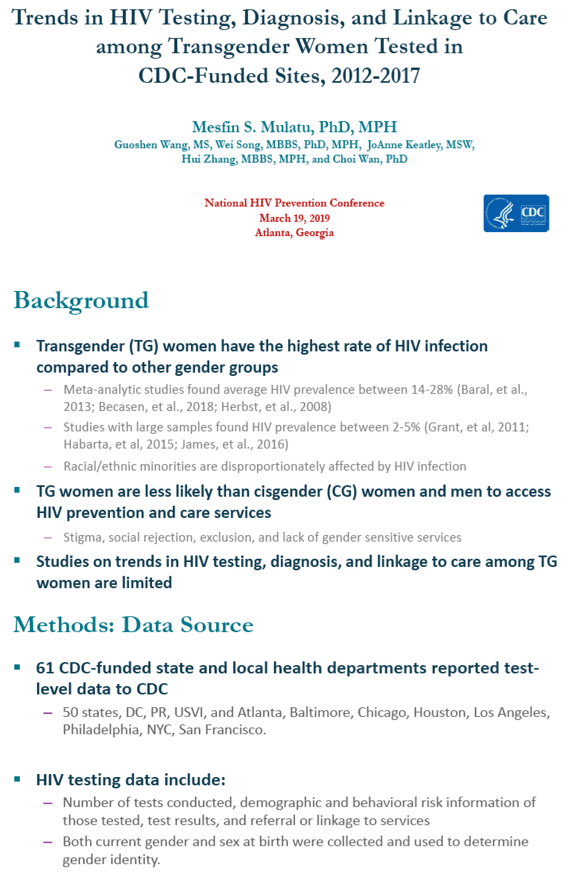
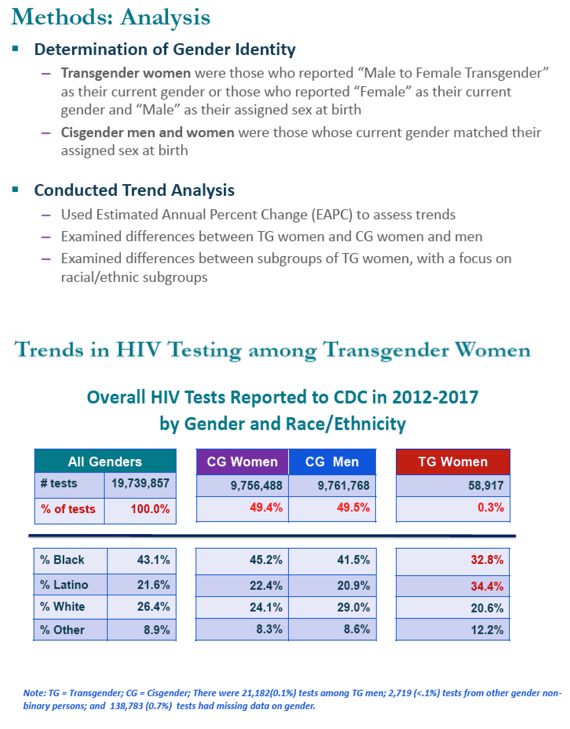
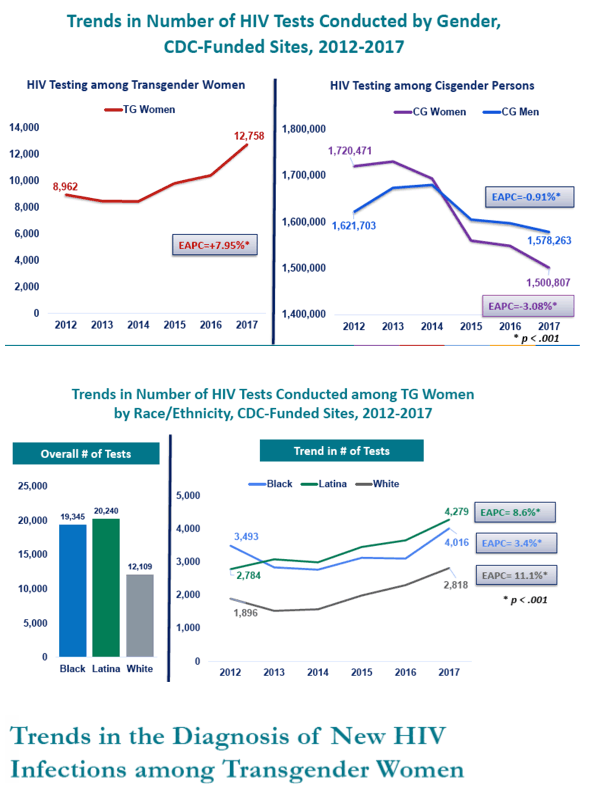
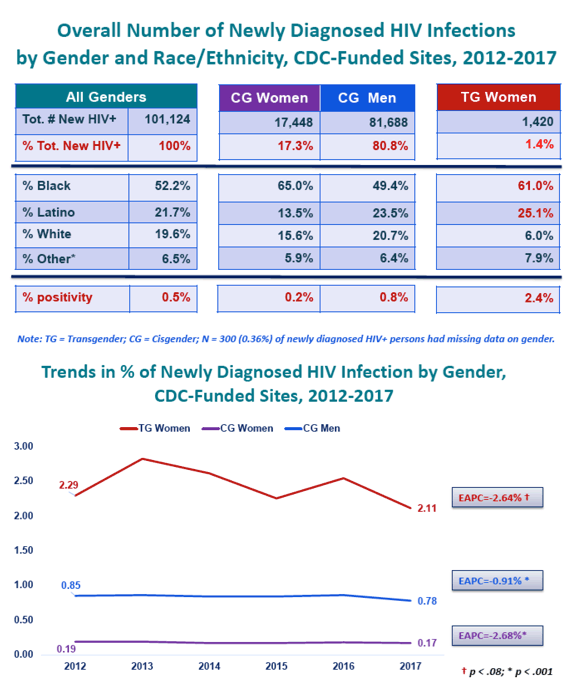
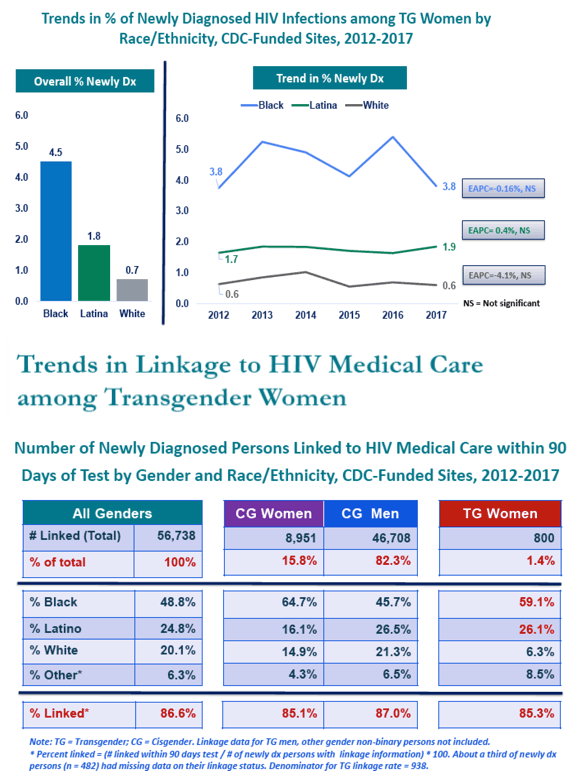
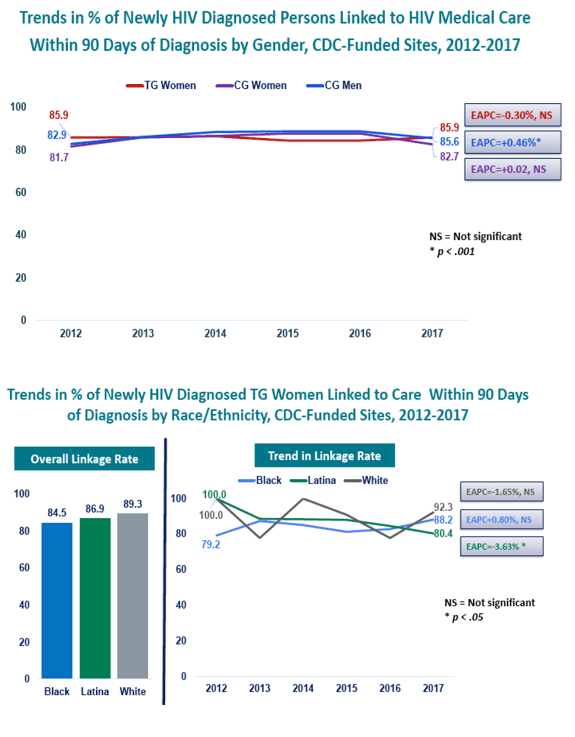
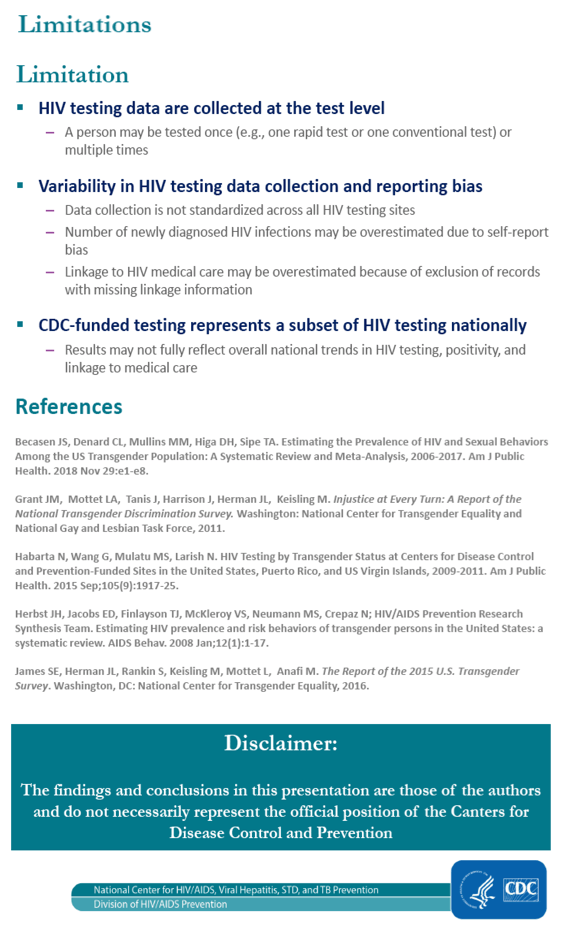
|
| |
|
 |
 |
|
|